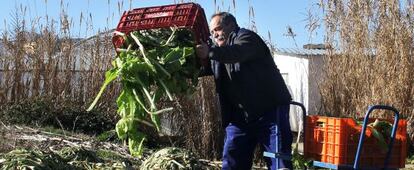An expanding waste line
Each year, the average Spaniard throws out 163 kilos of often perfectly edible food

An older woman hunches over a pile of fruit in the hallways of a Madrid market. This is the food that is going to be thrown away because it is past its “best before” date and can no longer be sold. But the woman inspects the fruit and selects the pieces that she will take home to eat.
There is nothing new about this image, but in recent years it has become more common. The dumpsters where supermarkets dispose of their products are a late-night meeting point for needy individuals. And there are growing numbers of them.
While some people are willing to eat what they find in the trash, the rest of European society wastes food that is perfectly fit to eat, to the tune of 179 kilos a year per inhabitant — that’s the equivalent of 89 million tons of food a year, as a European Parliament report laments. Spain throws out an annual average of 163 kilos per person, for a total of 7.7 million tons a year. This makes Spain the sixth most wasteful country in Europe after Germany (10.3), The Netherlands (9.4), France (9), Poland (8.9) and Italy (8.7).
The entire food chain is to blame for this squandering of good food, although individual consumers are more wasteful than producers, representing 42 percent of the total. “A lack of awareness, bad packaging and confusion regarding expiration dates are behind all this waste,” says Salvatore Caronna, the Euro-deputy who signed the study. “At a time when over 70 million people are experiencing poverty in Europe, we need to solve this problem.”
The first link in the food chain is the producer. According to Caronna’s report, 39 percent of food gets wasted at this stage. Lorenzo Ramos, president of the Union of Small Growers (UPA), asserts that products do not get thrown away except in crisis situations when the market collapses, as in the cucumber crisis of last summer, which depressed prices. “We normally pick everything and deliver everything,” says Ramos. “It’s the fruit and vegetable sorting centers that select the produce that is fit for selling and determine which percentage does not meet the standards.”
But Francisco González does not need a major crisis to throw away half of his chard production in Villa del Prado, southwest of Madrid. “When prices are really low, like 20 or 30 cents a kilo, I can’t even cover production costs, so I keep the leaves on the plant to see if the price goes up.” If it doesn’t, though, the leaves start to get small brown flecks. “You could still eat them, but they wouldn’t sell,” says González as he shows off a handful of brown-specked chard leaves he has just cut off. So he simply throws them away.
The green, healthy-looking chard will end up at a supermarket or on the menu of one of Spain’s 85,230 restaurants — the kitchens of which let over 63,000 tons of food go to waste every year, twice as much as 20 years ago, according to a report by Unilever Food Solutions that is backed by the Spanish Federation of the Hotel and Restaurant Industry (FEHR). According to this study, 60 percent of this waste is caused by bad planning when consumers buy their groceries. Another 30 percent gets wasted during meal preparation, and the remaining 10 percent is what diners leave on their plates.
Large restaurant chains, such as Grupo Vips, have computerized systems that estimate how much food they will need before placing an order. “In order to reduce waste, we also use Happy Hour: fresh products that cannot be returned get sold for 1.50 euros beginning at 11pm,” said a spokesperson for the group.
But family restaurants, the kind that serve daily specials, do not have such resources and must rely instead on personal experience. “We work more on a day-to-day basis, but some days we have too much food and others not enough,” says the manager of a restaurant in the Madrid suburbs.
Over at Mercado de Maravillas food market, stall owners try not to throw away food because, otherwise, “our numbers don’t add up,” says Constantino de Anta, a butcher. “When I see the meat is drying up, I give it away to a woman who comes begging on Fridays.” Many small store owners would be willing to do the same, but social support groups do not always have the resources to collect all the food that is offered to them.
The end of the line is the consumer, the biggest waster by far. “We have to make things easy for them,” says Enrique García, of the consumer association OCU. “There is not enough format variety, and labels do not indicate how to preserve the food.”
A common mistake is getting the “best before” date confused with the expiration date. The first is just an indication, but the product remains perfectly edible after it. The second marks the day after which eating the product would pose a health risk. The European Commission is working on a directive for dual-date labeling that would make things clearer.
Tu suscripción se está usando en otro dispositivo
¿Quieres añadir otro usuario a tu suscripción?
Si continúas leyendo en este dispositivo, no se podrá leer en el otro.
FlechaTu suscripción se está usando en otro dispositivo y solo puedes acceder a EL PAÍS desde un dispositivo a la vez.
Si quieres compartir tu cuenta, cambia tu suscripción a la modalidad Premium, así podrás añadir otro usuario. Cada uno accederá con su propia cuenta de email, lo que os permitirá personalizar vuestra experiencia en EL PAÍS.
¿Tienes una suscripción de empresa? Accede aquí para contratar más cuentas.
En el caso de no saber quién está usando tu cuenta, te recomendamos cambiar tu contraseña aquí.
Si decides continuar compartiendo tu cuenta, este mensaje se mostrará en tu dispositivo y en el de la otra persona que está usando tu cuenta de forma indefinida, afectando a tu experiencia de lectura. Puedes consultar aquí los términos y condiciones de la suscripción digital.
Últimas noticias
The complicated life of Francesca Albanese: A rising figure in Italy but barred from every bank by Trump’s sanctions
Pinochet’s victims grapple with José Antonio Kast’s rise in Chile
Reinhard Genzel, Nobel laureate in physics: ‘One-minute videos will never give you the truth’
From digital curfews to blocking apps: How technology experts protect their children online
Most viewed
- Why we lost the habit of sleeping in two segments and how that changed our sense of time
- Trump’s obsession with putting his name on everything is unprecedented in the United States
- Charles Dubouloz, mountaineering star, retires at 36 with a farewell tour inspired by Walter Bonatti
- The Florida Keys tourist paradise is besieged by immigration agents: ‘We’ve never seen anything like this’
- Living in a motorhome due to soaring housing prices in Madrid: ‘I got used to it quickly, but I don’t idealize it’









































